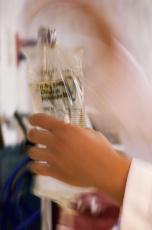 |
 |
 |
Other Health Topics:

-
Related Topics
-
Go Local
- Services and providers for Heat Illness in the U.S.
-
National Institutes of Health
- The primary NIH organization for research on Heat Illness is the National Institute on Aging
Languages
- Arabic (العربية)
- Bosnian (Bosanski)
- Chinese - Traditional (繁體中文)
- French (français)
- German (Deutsch)
- Haitian Creole (Kreyol)
- Portuguese (português)
- Somali (af Soomaali)
- Spanish (español)
- Vietnamese (Tiếng Việt)
Heat Illness
Also called: Sunstroke
Your body normally cools itself by sweating. During hot weather, especially with high humidity, sweating just isn't enough. Your body temperature can rise to dangerous levels and you can develop a heat illness. Most heat illnesses occur from staying out in the heat too long. Exercising too much for your age and physical condition are also factors. Older adults, young children and those who are sick or overweight are most at risk. Drinking fluids, replenishing salt and minerals and limiting time in the heat can help.
Heat-related illnesses include
- Heatstroke - a life-threatening illness in which body temperature may rise above 106° F in minutes; symptoms include dry skin, rapid, strong pulse and dizziness
- Heat exhaustion - an illness that can precede heatstroke; symptoms include heavy sweating, rapid breathing and a fast, weak pulse
- Heat cramps - muscle pains or spasms that happen during heavy exercise
- Heat rash - skin irritation from excessive sweating
Centers for Disease Control and Prevention
Start Here
-
Frequently Asked Questions (FAQ) about Extreme Heat(Centers for Disease Control and Prevention)
Also available in Spanish
-
Hyperthermia: Too Hot for Your Health
 (National Institute on Aging)
(National Institute on Aging)
Also available in Spanish
| Basics | Learn More | Multimedia & Cool Tools |
|---|---|---|
|
||
| Research | Reference Shelf | For You |
-
Overviews
- Extreme Heat(Federal Emergency Management Agency)
-
Latest News
-
Advice for Older Adults on Staying Safe in Hot Weather
 (07/31/2008, National Institute on Aging)
(07/31/2008, National Institute on Aging)
- Keep Your Cool in Hot Weather(07/16/2008, Centers for Disease Control and Prevention)
- Extreme Heat a Deadly Risk for Older Adults(07/01/2008, HealthDay)
- Crop Workers Have Highest Heat-Related Death Rate(06/19/2008, HealthDay)
-
Advice for Older Adults on Staying Safe in Hot Weather
-
Treatment
- Heat Cramps: First Aid(Mayo Foundation for Medical Education and Research)
- Heat Exhaustion: First Aid(Mayo Foundation for Medical Education and Research)
- Heatstroke: First Aid(Mayo Foundation for Medical Education and Research)
-
Prevention/Screening
-
Extreme Heat: Tips for Preventing Heat-Related Illness(Centers for Disease Control and Prevention)
Also available in Spanish
-
Heat Exhaustion and Heatstroke: What You Need to Know(American Academy of Family Physicians)
Also available in Spanish
-
Heat Waves(American Red Cross)
Also available in Spanish
-
Extreme Heat: Tips for Preventing Heat-Related Illness(Centers for Disease Control and Prevention)
-
Specific Conditions
- Heat Rash or Prickly Heat (Miliaria Rubra)(Logical Images)
-
Related Issues
- Dehydration(Mayo Foundation for Medical Education and Research)
- Heat Index(National Weather Service)
- Hot Weather and Cardiovascular Disease(American Heart Association)
-
Clinical Trials
-
ClinicalTrials.gov: Dehydration
 (National Institutes of Health)
(National Institutes of Health)
-
ClinicalTrials.gov: Heat Stress Disorders
 (National Institutes of Health)
(National Institutes of Health)
-
ClinicalTrials.gov: Dehydration
-
Journal Articles
References and abstracts from MEDLINE/PubMed (National Library of Medicine)
- Article: Leukocyte activation: the link between inflammation and coagulation during heatstroke....
- Article: Schizophreniform disorder after heat injury in a military recruit.
- Article: Heat cramps in sports.
- Heat Illness -- see more articles
-
Organizations
-
American Red Cross
Also available in Spanish
- National Center for Environmental Health(Centers for Disease Control and Prevention)
-
National Institute for Occupational Safety and Health
Also available in Spanish
-
National Institute on Aging

Also available in Spanish
-
American Red Cross
-
Children
- Heat Rash or Prickly Heat (Miliaria Rubra)(Logical Images)
- How to Be Safe When You're in the Sun(Nemours Foundation)
- Parents' and Coaches' Guide to Dehydration and Other Heat Illnesses in Children(National Athletic Trainers' Association) - Links to PDF
-
Teenagers
-
Dehydration(Nemours Foundation)
Also available in Spanish
- Dehydration and Youth Sports: Curb the Risk(Mayo Foundation for Medical Education and Research)
-
Dehydration(Nemours Foundation)
-
Seniors
-
Heat Stress in the Elderly(Centers for Disease Control and Prevention)
Also available in Spanish
-
Hyperthermia: Too Hot for Your Health
 (National Institute on Aging)
(National Institute on Aging)
Also available in Spanish
-
Keep it Cool in Hot Weather
 (National Institutes of Health)
(National Institutes of Health)
-
Heat Stress in the Elderly(Centers for Disease Control and Prevention)
| Home | Health Topics | Drugs & Supplements | Encyclopedia | Dictionary | News | Directories | Other Resources | |
| Copyright | Privacy | Accessibility | Quality Guidelines U.S. National Library of Medicine, 8600 Rockville Pike, Bethesda, MD 20894 National Institutes of Health | Department of Health & Human Services |
Date last updated: 10 September 2008 Topic last reviewed: 04 September 2008 |






